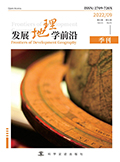

资源型城市作为国家能源供应体系的核心支柱, 为我国经济向环保低碳模式转型提供了坚实的物质基础。为促进“资源-环境-城市”协调发展, 科学评价其绿色转型效率至关重要。本研究以西北地区典型资源型城市嘉峪关市为例, 构建包含经济转型、社会转型、环境转型、绿色转型四个维度共14个指标的评价体系, 采用熵权-TOPSIS综合评价法, 对嘉峪关市2008—2018年间的绿色转型效率进行量化测度, 并进一步引入障碍度诊断模型, 系统识别阻碍其可持续发展的关键制约因素。最后, 针对发现的问题提出绿色转型发展的策略。结果表明: (1) 在经济转型方面, 嘉峪关市转型效能持续提升, 但仍维持在中等水平, 其中GDP贡献度最为突出; 在社会转型方面, 嘉峪关市在2015年以后取得显著进展, 达到较优状态; 在环境转型方面, 嘉峪关市在2012年进入到了优质阶段, 相对贴近度也在逐年上升; 在绿色转型方面, 嘉峪关市自2012年起即保持优质发展态势, 且转型质量指数呈稳定增长趋势, 相对贴近度呈现持续改善态势, 但增速较为平缓, 转型进程仍存在显著的提升空间。 (2) 2008—2018年, 嘉峪关市在经济转型、社会转型、环境转型、绿色转型方面, D+和D-的变化较明显, 绿色转型效率逐步接近最优理想解的发展水平。 (3) 市区空气质量达标天数比例 (X8) 与污水处理厂集中处理率 (X13) 是嘉峪关市绿色转型发展的主要障碍因子。
As the core pillar of the national energy supply system, resource-based cities provide a solid material foundation for China' s economic transformation towards an environmentally friendly and low-carbon model. It is crucial to scientifically evaluate the efficiency of green transformation in order to promote the coordinated development of . “resources environment cities”. Taking Jiayuguan City, a typical resourcebased city in northwest China, as an example, this study constructs an urban green transformation efficiency evaluation system from four dimensions of economic transformation, social transformation, environmental transformation, and green transformation, with 14 indicator evaluation factors. The entropy weight TOPSIS model is used to measure the green transformation efficiency of Jiayuguan City from 2008 to 2018, and the obstacle model is combined to evaluate the obstacle factors that affect the green transformation of Jiayuguan City. Finally, propose strategies for the green transformation and development in response to the identified issues. The results show that: (1) In terms of economic transformation, the efficiency of economic transformation in Jiayuguan City has been increasing year by year, but it is basically in the intermediate stage, with the highest GDP weight; In terms of social transformation, Jiayuguan City has made significant progress since 2015, reaching a relatively optimal state; In terms of environmental transformation, Jiayuguan City entered a high-quality stage in 2012, and its relative closeness has been increasing year by year; In terms of green transformation, Jiayuguan City has entered the high-quality stage from the initial stage since 2012, and its relative closeness has been increasing year by year. The relative closeness has shown a continuous improvement trend, but the growth rate is relatively slow, and there is still significant room for improvement in the transformation process (2) From 2008 to 2018, in terms of economic transformation, social transformation, environmental transformation, and green transformation, there were significant changes in D+and D-in Jiayuguan City, and the efficiency of green transformation gradually approached the development level of the optimal ideal solution. (3) The proportion of days when the urban air quality meets the standard (X8) and the centralized treatment rate of sewage treatment plants (X13) are the main obstacles to the green transformation and development of Jiayuguan City.